|
I. Marketing and Distribution Channels
This unit has a lot of extra material above and beyond
the textbook, as it is the area where I did my doctorate. It's also one
of my favourite areas of Marketing because it deals first in channels
which I find fascinating, and second in
large things that move!
Channels of Distribution is known as "Place" in the "4
P's" model of Marketing. Distribution Channels provide the utility of place,
of having products where the customer wants when the
customer wants them. In these days of customer focus and emphasis on competition,
the 4 P's model is considered very simplistic, and I've always thought
that was probably why Marketers began referring to Place as Channels,
to move us away from "The "4 P's" as a description of all
of what Marketing is about; nevertheless, "place" is a convenient way to
think of the term Channels of
Distribution.
| Distribution is particularly
important in a country like Canada with our huge size and our
northern climate. Every spring, trucks go down through the ice in
places where frozen water is used as a seasonal road; this truck is
sinking in Lake Winnipeg. |
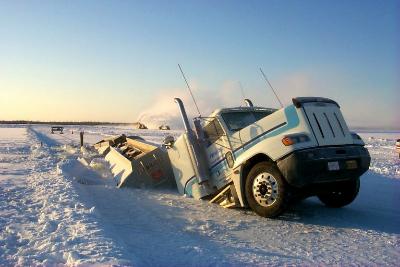 |
What is a Channel? |
|
| This was one of the hardest lectures to put onto
the web, partly because an Internet class misses the costume and
theatrics of when I teach it on-campus.
Although I usually dress in reasonably formal business attire for
my Intro Marketing lectures, on this day I show up in what I wear
when out doing my academic research on the trucking industry -- jeans, Peterbilt sweatshirt,
steel-toed boots, and yellow hardhat (see
a picture here of me with my truck), and I start class by writing
this question on the
board because it's part of my ongoing research project on the
image of truck drivers. Answer it now before you start work on the
chapter. |
 |
Exercise
Truckers |
Describe
a person who
drives a truck for a living.
Post your answer in the
Moodle Discussion Group. |
|
|
There are stereotypes out there
about truckers. One of the best representations of these
is from an article in the Toronto Star by Wheels columnist
Mark Richardson, where he uses stereotypes about truckers
to create a winning opening to the article. He is writing
about test driving the Mazda Miata MX-5 25th Anniversary
Edition. He brings out both the stereotypes of the rough
trucker and the more likely reality of a gentle happy
family man. Here is the start of Richardson's article from
Saturday, August 23, 2014 (by the way it's no
coincidence that he's talking about a little red Mazda MX5
- Miata, which is my own beloved little red car):
Roadster Even a Trucker
Will Love, Mark Richardson, Special to the Star
"The big trucker walked over to
where I was sitting in the restaurant and towered over my
table, hands on hips. His dark arms crawled with
tattoos beneath thick curled hair.
'Is that your Mazda outside?' he
said, with a deep diesel voice and a touch of Quebec. I
lowered my burger slowly to the plate, met his eyes and
gulped just a little. Any words would have wavered, so I
nodded, pretending to chew. Outside in the truck stop lot,
the little red convertible stood out like a drop of fresh
blood on a face pocked with Kenworths, Freightliners and
Macks. Much like the face of this trucker standing over
me, squinting down at the only car driver in the joint.
'What year is it? he asked. Is it
this year? I have a 2009 at home. It's a great car. May
I?' And he took the seat opposite, and I gulped again and
breathed a little easier. He told me about his car, and
about the drive he took last summer with his wife around
the Gaspe Peninsula. He said he loved its simplicity
because he spent his work days behind the wheel of a huge
tractor-trailer, rowing through 18 gears and constrained
by log books and places to be. With the little soft-top,
he and his wife could go where they wanted and enjoy the
feel of the drive again." (The article
continues).
|
Why Are Marketing Intermediaries
Used?
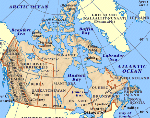 |
The answer is as simple
as looking at a map of Canada: 5,000 miles
coast to coast, a heck of a lot of roads & railroad track, and most of the manufacturing
centered in one part of the country. How are you as a manufacturer in southern
Ontario going to know what will sell in Kamloops, B.C.? |
Remember Johan Arndt in
Unit 1, who said that the true definition of Marketing is matching
supply and demand? That's one of the major reasons channels of
distribution are used - to match the supply of product in one place with
the demand for it in another. What's at the heart of Marketing Channels
(Place) can be summed up in fewer than 15 words, using
Professor
Li's model of understanding a topic:
| Golf
Balls: cheaper to make 5,000 at once but
consumers buy 5 at a time |
 |
|
How Channel Partners Add Value
By Function:
| Information |
 |
| Promotion |
 |
| Contact |
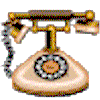 |
Matching and
Arranging
(including
such things as manufacturing, grading, assembling, and packaging) |
 |
| Negotiation |
 |
Physical
Distribution
(transporting and storing) |
 |
| Financing |
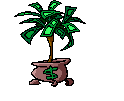 |
| Risk Taking |
 |
| After-Sales
Support |
|
| It's not a question of WHETHER we do these
functions but of WHO does them; they must be done in order for
products to be sold. |
 |
Exercise
- Plan
Functions |
For at
least three of these functions, describe specifically
what your Marketing Plan product will do to fulfill them.
Post your answer in the
Moodle Discussion Group. |
|
By Levels of
Distributors
| Direct
Manufacturer

Consumer |
|
Indirect
|
 |
There are three main theories about how
companies decide on what kinds and how many channels to use. If you're REALLY
interested in this stuff, you can go to the York
Library and check out my doctoral thesis but if you
don't need help getting to sleep, here's a brief
summary |
Economic
Perspective
Which arrangement is best in terms of
producing economies of scale and reducing overlap?
|
Behavioural
Perspective
Which arrangement is best in terms of how
people will feel, act, react? What are the costs (direct and
indirect) of organizing yourself in a particular way? Critical
issues here are power and
control,
competition, conflict, cooperation, roles, communication,
authority, and leadership
|
Transaction Cost
Analysis
TCA looks at both governance costs and
production costs, providing a way to put dollar amounts on
behavioural as well as economic costs. In the presence of small numbers of
suppliers, you decide whether you use something frequently
or not, how uncertain things are in your environment, and
how specifically geared to your own company the thing in
question is
Example: The Reefer
(the legal kind) |
 |
Suppose you own an ice cream business in a
small Ontario town. You deliver ice cream to local stores and restaurants. Even though it's a small
town, you still need a refrigerated trailer (reefer)
because ice cream melts fast. You make deliveries at all
hours, and you're never
sure when you may need get a call to deliver ice cream.
There is only one reefer available in your small town, the only one within a 600 mile radius. Do you want to own that reefer or rent it
from someone? Generally speaking it's better to buy in
the free open competitive Market
(rent it) unless these four things exist, in which case you
should include it as part of the Hierarchy
of your organization (own
it). Hence the thesis title: Channels Strategy and
The Use of Advertising Agencies: A Markets and Hierarchies
Model
|
Small numbers
- only one truck |
|
Frequency - you're using it all the time |
|
Uncertainty - you don't know when you'll need it |
|
Asset Specificity - reefer is specifically designed for
your purposes |
There -- an entire 241 page doctoral
thesis in fewer than 150 words! Only I did my thesis on the
question of whether a company uses the basics of transaction
cost theory in deciding whether to use a full-service ad
agency or do it in-house, something I came affectionately to
call the "in-house/outhouse question"
| Be very grateful! When
I was a newly-minted Doctor of Philosophy, teaching
my Marketing classes at York, I absolutely believed it
was totally necessary to take my students through a full
recitation of the details of the magnificent
logistic regression I recently had done for my doctoral thesis!
Now, years after becoming a PhD, I can
just tell it to you in under 150 words. |
|
 |
Exercise
- Plan
TCA |
Can you make this make sense in a world
you understand? What are the four elements of Transaction
Cost Analysis in relation to your Marketing Plan product?
Uncertainty is a given in any business venture, but are
there particular reasons why you face more uncertainty than
normal? Are there small numbers? Are there specific assets?
How about frequency?
Post your answer in the
Moodle Discussion Group. |
|
Types of Channel
Partners
Retailers
Wholesalers
Drop Shippers and Rack Jobbers
Brokers
Agents
Wholesalers
Wholesalers are generally used when they are
better at performing one or more of the Distribution Channel Functions
Functions of Wholesalers
|
Distribution Function |
Example for Wholesaling |
| Information |
Telling retailers about the competition |
| Product |
Building assortments needed by retailers |
| Price |
Reaching many small retailers at low cost |
| Place |
Providing quick delivery by being located closer to
retailer than the producers are |
| Promotion |
Having contacts with the buyer |
| Ownership |
Holding inventories, absorbing risk |
Types of Wholesalers
Wholesaler Marketing Decisions
Wholesalers make pretty much the same decisions
that retailers do, where their product is the assortment of products and
services they offer.
 |
Exercise
- Plan
Wholesaler Decisions |
What
kind of wholesaling decisions will have to be made about
your Marketing Plan product? Who will make them? Will
you use a traditional wholesaler or a new method? Tell
us about your decisions.
Post your answer in the
Moodle Discussion Group. |
|
Wholesaler Marketing Decisions
As well as decisions with the 4 P's:
Organization and
Management of Channels
Direct versus Indirect Channels
 |
Exercise
Where Do You Shop? |
Tell us
about some places where you shop and how you believe the
goods or services got there.
Post your answer in the
Moodle Discussion Group. |
|
Disintermediation
Vertical Marketing Systems
- Distribution
Strategy
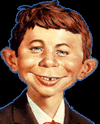
|
Channel design must
be part of your overall marketing strategy. Just as
you
wouldn't advertise a $20,000 Rolex watch in
 Magazine, likewise you wouldn't plan to sell
one in the Everything-For-A-Dollar store.
Magazine, likewise you wouldn't plan to sell
one in the Everything-For-A-Dollar store.
Check this out and think it through; I almost
always ask about it on the in-class test:
When
might you legitimately advertise a Rolex watch in Mad
Magazine? |
Analyzing Consumer Service Needs
 |
Exercise
- Plan
Channel Needs |
A channel's purpose is to deliver the product to the consumer.
Which system is going to best meet the needs of your Marketing
Plan customer?
What does your customer need in a channel?
Post your answer in the
Moodle Discussion Group. |
|
Setting Channel Objectives and
Constraints
What do you want to do, what in your situation
will help you and what will hinder you?
Identifying Major Alternatives
Types of Intermediaries
| Company
Sales Force - having your own in-house
sales force provides the most control over selling
activities, but entails high fixed costs and
supervision |
| Manufacturer's
Agency - using independent companies who
sell non-competing, complementary products to a
group of customers, paid a commission based on the
amount sold, can provide quick access to new
markets, but loyalty and selling effort must be
shared with other product lines |
| Wholesale
Distributors - these are independent
companies that specialize in the selling, storage,
and servicing of other business customers for a wide
variety of product lines. They may provide market
coverage over a large geographic area, but may carry
product lines of your competitors |
 |
Exercise
Types of Intermediaries |
For what kind of product might a manufacturer want to use their
own in-house sales force rather than using an outside
agency?
Post
your answer in the
Moodle Discussion Group. |
|
Number of Intermediaries - this is one of the core
concepts in Channel of Distribution. Will your product be available
everywhere, or will you sell your product either selectively, or perhaps
in only a few exclusive stores.
| Intensive
|
Stocking the product in as
many outlets as possible
Used for Convenience Goods
|
 Even
found sold in a boat floating down a deserted section of the Nile
River, says one Globe and Mail
reporter Even
found sold in a boat floating down a deserted section of the Nile
River, says one Globe and Mail
reporter
|
| Selective
|
Using more than one but fewer than all of
the intermediaries who are willing to carry the company's products
Used for Shopping Goods
|
 In a some select places; you may not find a GE
appliance in a small Mom&Pop store
In a some select places; you may not find a GE
appliance in a small Mom&Pop store
|
| Exclusive
|
Giving a limited number of
dealers the exclusive right to distribute the company's products in
their territories
Used for Specialty Goods
|
 You can't buy a Rolls
Royce or a Ferrari just anywhere You can't buy a Rolls
Royce or a Ferrari just anywhere
|
 |
Exercise- Plan
Number of Intermediaries |
How many
intermediaries will you use in distributing your
Marketing Plan product? Why?
Post your answer in the
Moodle Discussion Group. |
|
Horizontal and Hybrid Marketing
Systems
 |
Exercise
Innovation |
Can you
give an example of a distribution channel that was
specifically created for one type of product? Something
that didn't exist before that product needed to be
distributed, a channel that was created specifically for
a product.
Post your answer in the
Moodle Discussion Group. |
|
 |
Exercise:
Lab
Channel Captains |
Go to a
car dealership near you and talk to someone there about
conflicts that arise in their business, and whom they
might regard as "Channel Captains" (explain
the term to them as we use it here).
Post your answer in the
Moodle Discussion Group. |
|
 |
Exercise

Conflict |
Give an
example of multi-layer conflict; that is, where conflict
arises perhaps both horizontally and vertically.
Post your answer in the
Moodle Discussion Group. |
|
II. Retailing
Differences between the United States
and Canada
One of the things
I get asked at conferences, when people find out I'm from Canada,
is how is Canada different from the United States? I reply, in two
ways. First, Canadians know there is a difference and Americans
don't. But secondly, most Canadians believe in the greater good
for the greatest numer of people, while a whole lot of Americans
believe in the rights of the individual.
There are major differences between
shoppers in Canada and those in the United States. Keep this in
mind while you read this chapter. Note too the text's emphasis on
many new things in the Retail world, including online retail, and
social media and mobile devices.
Functions of Retailers
| Distribution Function |
Example for Retailing |
| Information |
Collecting information about customers in store |
| Product |
Advise manufacturer on product design changes |
| Price |
Offer smaller volume of goods for consumer to buy |
| Place |
Offer variety of products in one location for
consumer |
| Promotion |
Run own ads or team up with manufacturer in joint
ads |
| Ownership |
Absorb risk by taking title and bearing cost of
theft, damage, etc. |
Types of Retailers
Retailers are classified by:
 |
Exercise
Types of Retailers |
What
kind of retailer do you shop at most frequently?
Why?
Post
your answer in the
Moodle Discussion Group. |
|
Retailer Marketing Decisions
 |
Exercise
- Plan
Retailer Decisions |
From
among all these kinds of decisions that retailers have
to make, what kind will the retailer who handles your
Marketing Plan Product have to make? If you don't have a
retailer, what decisions will you be making in order to
market your product?
Post your answer in the
Moodle Discussion Group. |
|
The Wheel of Retailing
| If you've ever wondered why those great little
discount stores you go to don't seem to last forever, the Wheel of
Retailing theory explains why. As soon as a discount store starts to
get reasonably successful, usually they then start to imitate the
bigger mainstream stores, and soon they're not low-end enough to
afford to sell at discount prices any more. |
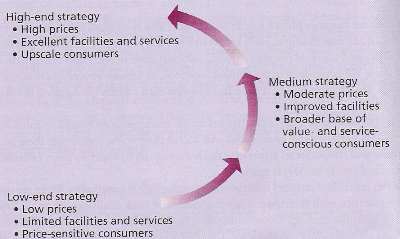 |
The Future of Retailing
III. Supply Chain Management and
Logistics
Nature and Importance of
Marketing Logistics
Goals of the Logistics System
Marketing
Plan Hint - What will work best
for how you want to serve your customer?
Think of this as the
"Trucks or Warehouses" decision.
Post your answer in the
Moodle Discussion Group. |

|

|
Do you want to promise immediate delivery,
in which case you'll need more trucks, or will your customers be happy with a regular but not-as-frequent
delivery, in which case you'll need more warehouses
|
Major Logistics Functions
Integrated Logistics Management
As with everything else about Marketing, it
all has to fit together into an integrated whole
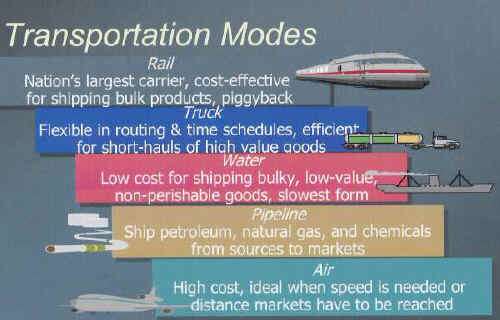 |
Logistics Technology - Changes in
Technology have had a huge effect on logistics, in most cases
making it far easier than it was in the past. One example is the
fitting of trucks with gadgets that will keep track of the truck
driver's location and time spent. Needless to say, this is not as
popular with drivers as it is with bosses.
Third Party Logistics - This is part of
the inhouse-or-outside question that I addressed in my thesis.
Some companies find it cheaper and easier to own their own trucks,
whereas others will find it a better choice to hire someone else
to do the moving.
Environmental
Impact of Logistics - this is becoming especially important
recently with all the movements to greener business practices.
|
|